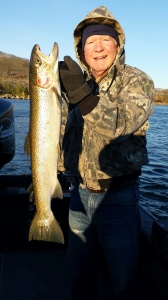Chasing Steelies
 You are no doubt aware that Homey Kirk Johnson and I, along with various and sundry close family, have a thing for the steelhead of fall.
You are no doubt aware that Homey Kirk Johnson and I, along with various and sundry close family, have a thing for the steelhead of fall.
Thus it was that Homey, my boyfriend-in-law Brian Smith and I found ourselves driving into Pateros at 6:30 a.m. a week ago. We were meeting up with Shane Magnuson for our annual steelhead adventure on the Upper Columbia and one or two tributaries. We were a few minutes late as a result of a dark-thirty, citation-free, confab with a very nice state patrol officer outside Wenatchee who wanted to talk fishing. Be that as it may, we climbed aboard Shane’s sled and were soon chasing steelies on an absolutely perfect fall day.
In this fishery, we would only be able to keep hatchery steelhead – those with a missing adipose fin – and would release all wild fish. Over the previous week or two, something around 70% of the fish had been keepers.
Steelheading on these stretches of water is a cast-and-drift effort, with Shane getting us in position and us attempting to get a lure or bait within striking distance of a strong, red-streaked, bright-sided fish. Through hour after hour of cast, drift and cast again, we had just enough action to keep our blood pressure at a healthy level. After a couple hours and one keeper on the Columbia, however, Shane had had enough, and we packed up to hit the Okanogan.
That short transition drive gave us a chance to compare notes on 2014 and earlier years. We talked about the brilliant chrome steelhead which Bill Boyum and I brought home with us from the Lower Columbia a few months back, and other regional steelie action. And, since it is what fishers do when things get quiet, we talked about the fair number of nice fish we’d taken up here on other trips. Somewhere in there, we decided we needed to get back to the Quinault – I may have reminded my team of the 24 pound steelhead I took on that river half a decade ago – and I agreed to reach out to Chopper, my Quinault fish-whispering buddy of many years.
By mid-morning, we were wending our way up the almost-too-shallow Okanogan. There were fish everywhere, but strikes were few. After we had caught one very nice wild fish, and lost another to a submerged rock, Shane suggested we change our approach.
“We need to make the fish angry,” he said. “Jim, you are the decoy. You must find ways to insult these fish enough to get them to strike. Brian and Kirk will man the rods,” Thus it was that on a beautiful, quiet, peaceful, cool, sunny day – on a river as picturesque as you will find anywhere – I found myself insulting steelhead, with language strange to my tongue. Totally out of character, of course, for a man as sweet a I am, but I did my best. I insulted steelhead looks, parentage, behavior, mate choices and most anything else I could imagine. It worked.
Over the next couple hours, we caught six or eight untamed fish, missed that many strikes, and added a keeper to the boat. It was as good a day as any of us could recall.
As we pointed the rig toward home, Brian noted that a good number of people (including many fisheries biologists) do not have my understanding of how our steelies evolved. He pointed out my obligation to pass knowledge along. Fine. Here.
Quite simply, steelhead are sea-run rainbow trout. It’s not that simple, of course. They are anadromous – meaning that they are “bi,” enjoying the pleasures of both fresh AND salt water. It all started when a rainbow got large enough to develop a taste for ferrous minerals. It headed for the ocean and places where the underlying rock (and the water itself) was rich in iron. The shrimp and salt-water prey of this first sea-run trout were also very high in dissolved iron. That iron, in turn, was absorbed in the bony parts of the sea-run rainbow. By the time that first sea-run rainbow returned to fresh water, its bones – and skull – were nearly entirely iron. As others joined that first pioneer, they became exceptionally heavy, strong, fighting fish. Much of their beauty is the result of that iron leaking out through their gills, staining their sides with an almost iridescent red color. The first European to catch one of these fish did so accidently when he dropped his magnetic watch fob into the Columbia, and immediately found himself chained to a twelve-pound trout. The fish is probably more appropriately named “ironhead,” but you know how biologists are. You will also note that, in the Washington State Fishing Rules booklet, the use of magnets in ironheading is not listed as a legal method of take.
Steelheading; one more way to make fall a special time.







